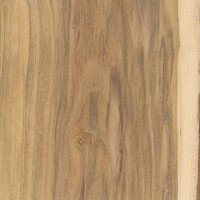
|
Common Name(s): Plum
Scientific Name: Prunus domestica Distribution: Widely cultivated in temperate areas worldwide Tree Size: 20-40 ft (6-12 m) tall, 1-1.5 ft (.3-.4 m) trunk diameter Average Dried Weight: 50 lbs/ft3 (795 kg/m3) Specific Gravity (Basic, 12% MC): .61, .79 Janka Hardness: 1,550 lbf (6,900 N)* *Estimated hardness based on specific gravity Modulus of Rupture: 12,810 lbf/in2 (88.4 MPa) Elastic Modulus: 1,478,000 lbf/in2 (10.19 GPa) Crushing Strength: No data available Shrinkage: No data available |
Color/Appearance: Plum heartwood can exhibit a cornucopia of colors, typically a yellowish brown, with streaks of pink, orange, red, purple, olive, or gray mixed in. Because of the small size of plum trees, swirled or irregular grain, as well as knots and other defects are common.
Grain/Texture: Has a fine texture with close grain and a slight natural luster.
Endgrain: Semi-ring-porous to diffuse-porous; small pores, sometimes arranged diagonally, numerous to very numerous; solitary and radial multiples of 2-3; mineral/gum deposits occasionally present, though not easily seen with lens; growth rings usually distinct due to a concentration of earlywood pores; parenchyma marginal; medium to wide rays, spacing normal.
Rot Resistance: No data available.
Workability: Areas with straight and clear grain are easy to work with hand or machine tools. Care must be taken when surfacing irregular grain or knots to avoid tearout. Plum glues, turns, and finishes well.
Odor: Plum has a distinct scent while being worked that is reminiscent of pumpkin or squash.
Allergies/Toxicity: Although there have been no adverse health effects reported for Plum, the closely related Black Cherry has been reported to cause respiratory effects. See the articles Wood Allergies and Toxicity and Wood Dust Safety for more information.
Pricing/Availability: Not commercially available in lumber form due to very small tree sizes, Plum is most commonly seen among hobbyists and other small specialty woodworkers and related retailers. Most commonly sold in turning blanks or other small sections. Prices are likely to be high for a domestic wood.
Sustainability: This wood species is not listed in the CITES Appendices or on the IUCN Red List of Threatened Species.
Common Uses: Turned objects, musical instruments, inlay, and knife handles.
Comments: Although Plum is related to Cherry, it tends to be heavier and harder than Cherry, and much more scarce. Sizes are very limited, so Plum tends to be assigned primarily to smaller, more decorative purposes.
 |
 |
 |
 |





Hi Eric please find a better picture that better shows off the colours found in plum i like them so much that i prefer this wood over rosewoods when it has good pinks, purples and
Reds.
I often compare the really good pieces to Zitan, Chinese Rosewood and Bois De Rose
we have just cut down our plum tree and gave the neighbor most of the wood for turning and crafts… but i have the stump sitting 5″ above the ground right now and am wondering the best method of sealing and lightly staining possibly this piece as a momento of our memories of this tree which has stood close to our front door for years. Maybe an end table top about 3″ thick is what I am thinking. When I wet it outside it darkens up and looks so gorgeous so i can’t wait for the best ideas, any help… Read more »
Spar varnish is made for exterior finish. My experience with yrs of using it on boat “bright-work” found it needed to be lightly scraped and refinished about yearly, as the UV inhibitors eventually degrade in months of sunlight. Wood will appear wet and slightly darkened with 1-3 coats.
Just cut down a 16-17 year old plum tree due to boring insect that had already killed 2/3 of the tree. Made a few good end cuts and will preserve some of the larger pieces. The attached image shows the depth of color of the fresh cut wood. Water bring back that color and I’m hoping that if I work a few piece before they dry too much I can preserve that color as well. This is definitely wood with some twist in the trunk so it will be a challenge.
Sanded and waxed
Our tree collapsed and I wish I would of read this before I allowed the lads to saw it up its now in big logs and been out all winter in the rain. Guilty because it was Dads. Any idea what I can have made with it and how, I fancy musical instruments for the Grandkids.
I have a Bulgarian Kaval (end-blown flute) made of plum wood:
Have two logs of plum grown as fruit trees which died due to black growth of limbs. The remaining stumps ares are approx 5 foot tall and about 6 ” dia at top. Stumps are spiraled twisted and appear solid. Plan on cutting down and drying. Would like suggestions on how to handle and whether to use as laminate, boards, or leave whole for effect. Suggestions on how to remove bark most effectively etc. Thanks
I might be two years to late, but for anyone else who might have plumb that they want to cut up, I just wanted to mention that if you quarter saw it, it can have a beautiful fleck pattern. Similar to quarter sawn oak. Se the attached photo.
I retrieved some plum logs a couple of years ago, and I discovered that if you leave the bark on while it dries, color from the bark leaches into the wood. Really gorgeous and full of character.